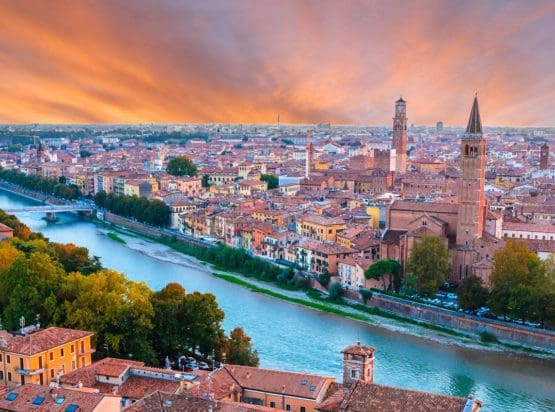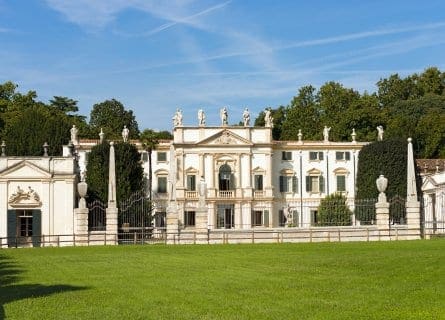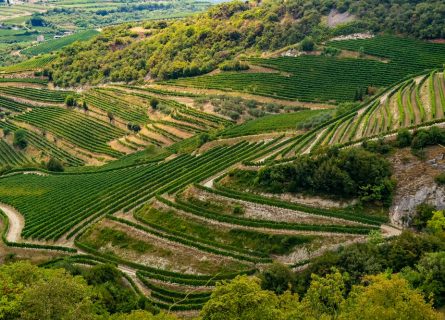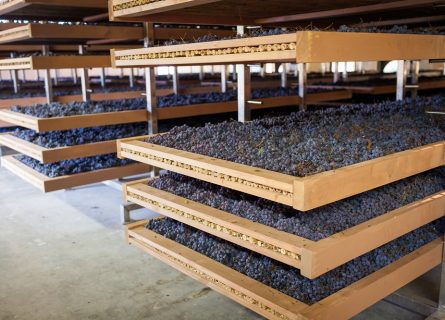Verona: A blend of romance, history, and culture, famous for Juliet's balcony, Roman amphitheater, and vibrant wine and opera scene.
Read more
EXPLORE ALL OUR VENETO WINE REGION GUIDES
Last updated: May 28, 2024
The ‘valley of the many cellars’ has been producing high-quality wines since the days of the ancient Greeks. Situated to the northwest of the elegant Roman town of Verona, its vineyards are found in the foothills of Monte Lessini – the Veronese have long regarded the area as their home from home, building lavish palaces and retreats that include the spectacular Villa della Torre. It is here, in this bucolic paradise, that northeastern Italy’s most famous red is made. We’re talking, of course, about Amarone della Valpolicella: an unbelievably rich and potent concoction that can handle any gastronomic surprise you throw at it. In the 20th century, vineyard expansion and belt-tightening damaged Valpolicella’s reputation somewhat, as high yields and poor winemaking took their toll. But, new investments and improvements in viticulture have atoned for past mistakes. Once again, Valpolicella is a fine wine region to take seriously.

Valpolicella is no stranger to the vine. In the ancient period, Phoenician traders introduced numerous grape varieties to northern Italy via the French port of Marseille. Indeed, Amarone della Valpolicella is a direct descendant of Greek passito wines that predate the Romans for several centuries. Pliny the Elder and other Roman authors of the period enjoyed these sweet beverages. At the same time, Verona prospered as a trade center with ancient gates, a forum (now Piazza delle Erbe), and a grand Roman arena – al fresco opera has been held in this architectural masterpiece for over 2000 years! However, after the Western Roman Empire fell into ruin in the 5th century, Verona was attacked by several Germanic tribes, including the Ostrogoths and Byzantines. Interestingly, Roman records suggest that the Ostrogoths were particularly fond of the local passito wines enjoyed at court throughout the so-called Dark Ages.
By AD 643, the Lombards had conquered most of the Italian Peninsula. One of their most important kings, Rotari, was the first on record to offer legal protection to the winegrowers of Valpolicella; he signed an edict outlawing both the theft of vines and damage to the crop. This was of enormous benefit to the producers of Valpolicella. However, the Lombards were ousted by the Franks in 773. Nevertheless, the early Middle Ages saw winegrowing flourish in the Lessini hills as the Republic of Venice assumed control of the lucrative export business. Yet many of the grapes planted were of Greek origin; Italian varieties did not start to appear en masse until the 1500s, partly due to an ongoing conflict with the Ottoman Turks and their repeated blockades of Venetian ports. As a result, investors were forced to turn to indigenous styles, such as Valpolicella’s Corvina and Rondinella. It was a golden age for the vineyards of northeastern Italy.
Unfortunately, the same cannot be said about the 1800s. A combination of vine diseases, political upheaval, and economic contraction saw a natural decline in quality in the latter half of the century. This stagnation only worsened in the 20th century, despite the award of appellation status in 1968. Yet a concurrent drive to significantly expand production saw the DOC boundaries extend far beyond the original Classico zone until it reached the border with Soave. And, as every oenophile knows, a dramatic increase in quantity leads to a drop in quality – a terrible decline in the case of Valpolicella. The authorities demarcated the original vineyards as Valpolicella Classico to remedy this situation, encouraging growers to pursue lower yields and chase higher quality. This has generally been a success, although the real trendsetters like Anselmi often bypass the regulations entirely, like their counterparts in Rioja.

Valpolicella is an intensely beautiful and unspoiled region characterized by the steep, vine-laced ridges that run alongside its gurgling mountain streams. The area under vine, much expanded in the 1900s, begins east of Lake Garda and extends to Montecchia di Crosara. This very pretty village is within touching distance of the Soave Superiore zone. Indeed, the region is dotted with pretty villages and hamlets, including San Pietro in Cariano – admired for its gorgeous Venetian Villas – and Marano. Verona is just a short drive away and second only to Rome in the number of fascinating Roman ruins. If you are based in Verona, Valpolicella makes for a perfect day trip wine excursion.
The region’s most exalted vineyards are all found in the original Classico zone, situated in the western section of Valpolicella to the east of Bardolino. With justification, it has long been argued that the appellation’s unofficial ‘Grand Cru’ terroirs are situated in four valleys stretching out of the Lessini Mountains; critics refer to them as the ‘fingers’ of Valpolicella’s open palm. These very pretty climats (vineyard sites) shadow Fumane, Marano, and Negrar villages, rising to 600 meters above sea level in some places. Combined with the infertile soils and favorable aspects, that fact ensures that the best of Valpolicella Classico is concentrated, fresh, and precise. To the east is the Valpantena subzone.

There are two sides to Valpolicella’s sizable wine industry. On the one hand, mass-produced red blends made by the cooperatives and volume-led producers are often tart and dilute – an unworthy flagship for northern Italy. While standards have improved dramatically in recent times, there is still some poor wine marketed under the Valpolicella DOC framework. That said, a well-made bottle of ‘ordinary Valpolicella’ can represent exceptional value for money: aromas of sour cherry lead into a light-bodied red of real charm. Its sappy fruit and gentle bitterness invoke the wines of Beaujolais – softly structured and best enjoyed slightly chilled.
However, Valpolicella Classico is an entirely different matter. The best examples are serious, bold expressions of variety and terroir, with enough structure to improve in bottle for at least a decade. Traditionally, the Consorzio imposed a maximum of 70% on the Corvina component – this versatile red grape is universally regarded as one of Valpolicella’s finest varieties. In addition, the DOC rules once demanded the inclusion of the tart and inferior Molinara. This is reminiscent of the situation in Chianti Classico in the 20th century when Trebbiano Toscano was mandated as a worthy component in the blends. Of course, this was transparent nonsense: Trebbiano added nothing to Chianti. However, pressure from growers ensured that it remained part of the Chianti recipe until 2006. Likewise, including Molina is no longer required in Valpolicella Classico, although the neutral Rondinella must still constitute at least 5 percent.
Nevertheless, the liberalization of the framework (95% Corvina wines are now permitted) has done wonders for the zone’s reputation. Many wineries prefer to vinify their grapes in stainless steel, using temperature control to extract every last bit of flavor and elegance from Corvina, which inevitably forms at least 85% of the blend today. To enhance weight and complexity, some of the most prestigious cuvées will be aged in wood – French barrique or possibly Slavonian.
The most potent form of Valpolicella is Recioto or Amarone, respectively, the sweet and dry results of drying grapes in warehouses for about three months (traditionally, this was done outside) to produce highly concentrated and voluptuous wines. Venetian merchants made such wines in the Middle Ages based on techniques introduced by the ancient Greeks! Today, respected houses like San Michele ferment their base wines in a mixture of stainless steel and oak vats. Maturation occurs in French barrique and larger tonneau (900 liters) barrels for at least 48 months. The results in bottle are memorable: a cornucopia of ripe fruit, spices, and exceptional length.
Forty years ago, a great deal of wine produced in this expansive zone was of substandard quality; high yields and low price ceilings prevented all but the most conscientious growers from marketing premium reds. As a result, Valpolicella coasted along while its competitors in Tuscany and Piedmont electrified critics and seduced collectors. It was mired in the worst kind of apathy, which in turn engendered widespread mediocrity.
But times have changed in Valpolicella, and the modern generation wants to dazzle us with their creations rather than simply make commercially viable supermarket fodder. The leading estates have great ambitions for Valpolicella Classico and Amarone, seeing them, with ample justification, as one of Italy’s greatest wine styles. At its best, Valpolicella is a most seductive red – a marriage of fruit and vibrant acidity. It is also relatively light on the palate and low in alcohol, two qualities trendy sommeliers and Millennial consumers now demand from their brands. Meanwhile, the faithful continue to find much pleasure in the rich, chocolate-scented wines of Amarone despite their hefty alcohol and massive structure. Amarone’s brute force of flavor might turn off true, younger drinkers. However, there are enough acolytes to ensure that this piece of Veneto history is a long way from becoming an anachronism.
Some improvements were borne out of capital investment: new winery kit, stainless steel tanks, and laboratories. Yet far more important has been a renewed appreciation of the region’s exceptional terroir: ancient limestone and volcanic soils, high-elevation terraces that benefit from diurnal temperature variation, and south-facing aspects. At the same time, cooperative dominance has weakened in Valpolicella, while small estates are cropping up like fungi porcini in the fall. A great deal of excitement has coalesced around the organic and biodynamic movement, in addition to the rising number of single-site bottlings and micro-production cuvées. Occasionally, a well-known producer will withdraw from the appellation framework altogether, giving them more freedom to experiment. All in all, this is a brilliant time to get acquainted with Valpolicella wines.
Discover Piedmont and Nebbiolo: A Noble Marriage of Grape and Terroir. Explore the essence of Nebbiolo in the Langhe hills of northern Italy.
Find out moreCorvina, known as Corvina Veronese or Cruina, is primarily grown in Italy's Veneto region, with a small presence in Argentina. It's key to producing Bardolino and Valpolicella wines, offering mild fruity flavors with almond hints. Integral in Amarone and Recioto wine-making, Corvina yields light to medium-bodied wines with high acidity, low tannins, and a potential sour-cherry finish.
Corvinone is a red grape from the Veneto region in northeast Italy, primarily used in Valpolicella wines and Corvina, Rondinella, and Molinara. It shares some similarities with Corvina, such as requiring hillside sites on poor soil and being thick-skinned, making both suitable for drying in Amarone and Recioto wines.
Molinara, a light-bodied Italian red grape, is mainly blended in Valpolicella and Bardolino wines, valued for its high acidity rather than flavor, often overshadowed by other varieties. Its tendency to oxidize has led to reduced cultivation, but it remains integral to Valpolicella due to appellation regulations.
Rondinella is a red grape from Italy's Veneto, mainly found in Valpolicella and Bardolino blends, prized for its high, consistent yields rather than its quality. Seldom made into a single-varietal wine, it adds herbal notes to Corvina-based blends and suits the grape-drying appassimento process.
Veronese gastronomy is second to none. The signature dish of Valpolicella is Risotto all’Amarone – Risotto rice slowly cooked in a mixture of Amarone wine and stock, creating a velvety, creamy sensation of a dish. Yet not every culinary creation relies on the local drop; feast on risotto alla seppie (cuttlefish-ink risotto) and polenta con le quaglie (polenta with quails) before attempting to find room for dessert. Most foodies head to their nearest gelateria.
A Guide to the Gastronomy and Cuisine of the Veneto: Read more
If you would like us to customize an exclusive luxury tour, contact us and let us know your travel plans. We offer luxury food and wine tours for private groups of a minimum two guests. In addition, all of our private, chauffeured tours are available year-round upon request.

